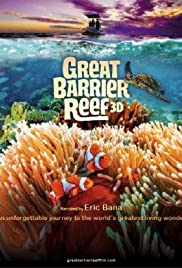
GREAT BARRIER REEF
IMAX, 3-D.
Australia, 2018, 45 minutes, Colour.
Narrated by Eric Bana. With Jemma Craig, Peter Gash.
Directed by Stephen Armezdroz
This is a film that can be seen by all audiences, from primary school audiences to grandparents, even great-grandparents! It is a film that can be recommended.
Over the years, there have been many documentaries about the Reef, including a 2015 film hosted by David Attenborough. However, this film is different. For a start, it is filmed in IMAX format, a huge screen, presenting spectacular underwater photography as Well Is surprising overhead drone photography with huge impact. And, as well, it is filmed in 3-D, enabling a very close encounter with all the living creatures, fish and plant, in the reef which stretches over 1000 km along the Queensland coast.
What makes this film significant, even important, is not that it is, as the director remarks, tabloid in its presentation of issues. The aim is not to sensationalise but to present the life and vitality of the reef in all its wonder. Obviously, it does campaign for activity concerning climate change and illustrates it profoundly. The film takes the camera under the water (and, there are many close-ups of the sophisticated cameras in action with the divers), shows us this world, gives explanations, information about so many of the creatures, the nature of the reef itself, polyps and anemones, the effect of the Crown of Thorns predator destroying the reef (and activists showing how, with an injection of image vinegar, they can be overcome).
There is a voice-over narrative, friendly, by Eric Bana. But communication relies on audiences identifying with Jemma Craig, who grew up on the reef island, Green Island, she and her brother with their parents, learning in the sea from an earliest age. We accompany her underwater, listening to her story, her experiences, her concerns, travelling on a boat that patrols the reef, rescuing a floating (disabled) turtle (after some vivid panoramas of turtles gathering annually at the reef), taking it to Fitzroy Island with the headquarters for the voluntary Turtle Rehabilitation Centre, and her reminding us that we are in the social media age and her showing us her extensive blog.
There is also a visit to Lady Elliot Island, a rehabilitated island, the mining of guano deposits, and, in the 1970s, the establishing of resort centre which is an eco-resort centre, established by pilot Peter gash, who also appears in the film and accompanies Jemma underwater. There are extensive activities for the visitors to the resort, taking them underwater, but also encouraging them to participate in activities which contribute to scientific knowledge (vivid scenes of swimming under Manta Rays, photographing them and computer identification of all these Manta Rays). Sequences of sharks, Minke whales, vast schools of extraordinary fish, vast visions of coral.
(One of the effects of watching this film is probably an increase in bookings to Lady Elliot Island and Fitzroy Island as well is of Jemma Craig’s blog.
A visit to IMAX, if it were possible, would be an excellent outing for school children, especially those in primary school who are discovering such wonders of the world as the Great Barrier Reef, are caught up in the concern about climate change, who can see so many possibilities for careers, imagining themselves working with the creatures, diving under the reef, working in the ever increasing sophisticated laboratories advancing scientific research ever more quickly.